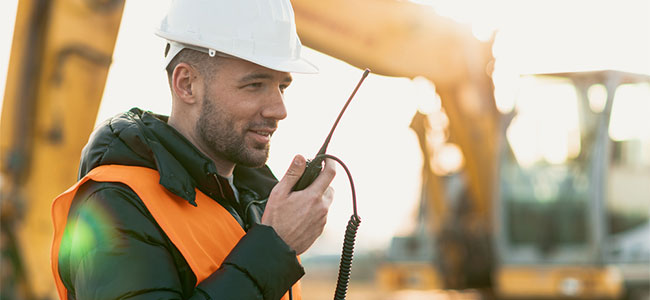
Benefits of Two-Way Radios for Construction Job Sites
Construction crews need to be able to communicate instantly, and on a job site, the best way to instantly communicate is through two-way radios.
- By Stewart McClintic
- Nov 09, 2023
When it comes to managing a construction site, nothing is more important than effective and efficient communication. A construction crew that can quickly talk to each other will complete jobs quicker and, most importantly, create a safer work environment on site. However, effective communication is not possible without the proper tools. A job site can span massive acreage with hundreds of workers, ranging from your construction contractors to multiple foremen managing a job. Some smaller job sites might meet in person or make a phone call on a cell phone. But service can be dicey, and leaving your work to find your crewmate is not the best use of time. Construction crews need to be able to communicate instantly, and on a job site, the best way to instantly communicate is through two-way radios. Two-way radios are a huge boon for construction crews. Here are the benefits of two-way radios for construction crews.
Instant Communication
The biggest benefit of two-way radios is their ability to create instant push-to-talk communication to a large group or an individual on a job site. A high-powered radio can send communication signals over long distances and through thick walls and barriers. Two-way radios ensure construction workers can communicate quickly and clearly. Any worker can instantly communicate with anyone else on a job site. Construction executives should also invest in earpieces for their teams to ensure every worker can also have hands-free communication. Construction crews should have two-way radios of at least four watts and multiple channels for individual and group communication. A smaller two-watt radio might work for small job sites but is too low-power for a vast majority of job sites.
Time is money on a construction job site and instant communication between the team means no one—from a worker to a foreman to a machine operator—has to go out and physically find each other on a large and noisy job site. These short trips seem like nothing on their own, but they do add up over time. Avoiding them will help your teams spend more time on the actual work.
Safer Job Sites
Construction professionals know that a job site is not the safest place to be. An accident or OSHA violation can happen at any moment due to broken machines, environmental hazards and employee incompetence. A two-way radio is a key tool in preventing accidents and alerting the right people quickly when they happen. Alert the entire team to avoid a certain area or inform the right team members to repair or dispose of faulty equipment. Being able to alert your team of real and potential dangers will lead to safer job sites and save your construction company from costly fines for safety violations.
Sturdy, Reliable and Cost-Effective
Two-way radios are a more efficient and cost-effective option for a job site. Compared to cell phones, a two-way radio costs less upfront and has no monthly plan fees. You could purchase your construction crew a pack of six two-way radios for the same cost as buying one cellphone. Two-way radios have stronger signal strength than a phone on a construction site. So you are going to get clearer team communication. A good two-way radio is sturdy and won’t break if it is dropped, stepped on or wet. Construction crews should use radios that meet IP54/55 military specifications 810 C, D, E and F, meaning the radio is heavily resistant to shock, rain, humidity, salt, fog, vibrations, sand, dust and high temperatures. These radios can take a beating, last a long time and, most importantly, not break the bank.
Things to Consider and Recommendations
When you are looking for two-way radios know the average size of a job site you work at. If your company frequently works on large job sites or on multiple sites at once that need to communicate, then you are going to need to get a repeater. A repeater is a signal booster that will significantly expand your communication range.
Any construction crew working extensively with two-way radios needs to make sure their radios are licensed. This is required by the Federal Communications Commission (FCC). It will help prevent channel overlap and make your communication more secure. Getting a license will prevent fines by the FCC, but it also just makes your two-way radio usage more efficient since you'll have your own frequencies.
Two-way radios come in two types: analog and digital. A vast majority of radios are digital these days. Digital is the future of two-way radio technology. It provides clearer communication over a longer distance on average. There are no monthly fees for going digital over analog. Only choose analog radios for an experienced construction company that already has an established infrastructure for analog radios. Make sure any digital or analog radio is fitted with military specs as those are the most durable.
Two-way radios are an essential communication tool for any construction crew. Their ability to provide instant, clear communication at the push of a button means crew members can make their construction site a more efficient and safer worksite.